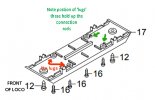I have this loco apart to convert it to DCC, but my continuity tester only lights when I touch it to an internal contact and a "skate" between the wheels. Not the wheels and the contact.
Is there a certain cleaner that should be used for the "carbon brushes" behind the wheels?
Is there a certain cleaner that should be used for the "carbon brushes" behind the wheels?

